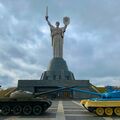Вопросы
Чтобы оставлять отзывы на акцию, вам нужно авторизоваться или зарегестрироваться
The MotherLand monument is great! It has a gorgeous view. It's on top of a hill so the view is great. You will have the Museum in there as well. It has a beautiful green area. While you walk in there, you will see trucks, tanks from the war. Would recommend it. You can easily access it by a long walking from city centre or by bus/uber.

Tahle socha mne fascinovala od chvíle, kdy jsem zauvažovala o návštěvě Kyjeva. Je větší, než jsem myslela a vydržela bych se na ni dívat hodiny. Už při příletu jsem ji zahlédla z letadla - tak dominantní monument to je. Do muzea války ani do sochy jsem nešla, zajímalo nás více muzeum Making of the Ukrainian Nation Museum, které je také v bezprostřední blízkosti. Ráda bych se do Kyjeva vrátila a znovu mohla Matku Vlast a okolí vidět.
It is a Communist-era statue in remembrance of the fighting in WWII. Kiev and the wider Ukraine region saw a great deal of fighting during this time. The statue is the second tallest in Europe (the tallest is in Volgograd in Russia), but there are many taller statues in Asia now. It depicts a tall, robed woman with a stern expression, the colour of burnished steel, holding a sword and shield aloft. It dwarfs the Statue of Liberty in New York. There is a viewing platform behind the shield, but we did not go to this and I’m not sure that it was open. In the plaza in front of the statue were three tanks, one painted in the yellow and blue colours of Ukraine, the other two facing the painted tank and in normal colours.Beneath the statue is a large museum set into the hill itself. This is dedicated to the Second World War. However, the exhibits one sees immediately after entering and paying the entrance fee were actually of the conflict in the Donbass. The WWII section was more difficult to understand, as much of it was primary documents from the time and thus either in Russian, Ukrainian or (less frequently) in German. It told the story of the conflict through the outbreak of the war between the Nazis and the Soviets in 1941 through to the fall of Berlin in 1945. There was even a section showing captured katanas from Japanese officers when the Soviets conquered the Kwantung Army in Manchuria in 1945. Above this was another floor, forming the interior of the pedestal. This was covered with murals and names. We couldn’t figure out the names, but they seemed to be the names of generals, as the first name in the list was Zhukov’s, who was the highest ranking Red Army officer. If this was the case, the sheer number of generals gave an idea of the bewildering scale of the conflict; the largest in human history.







